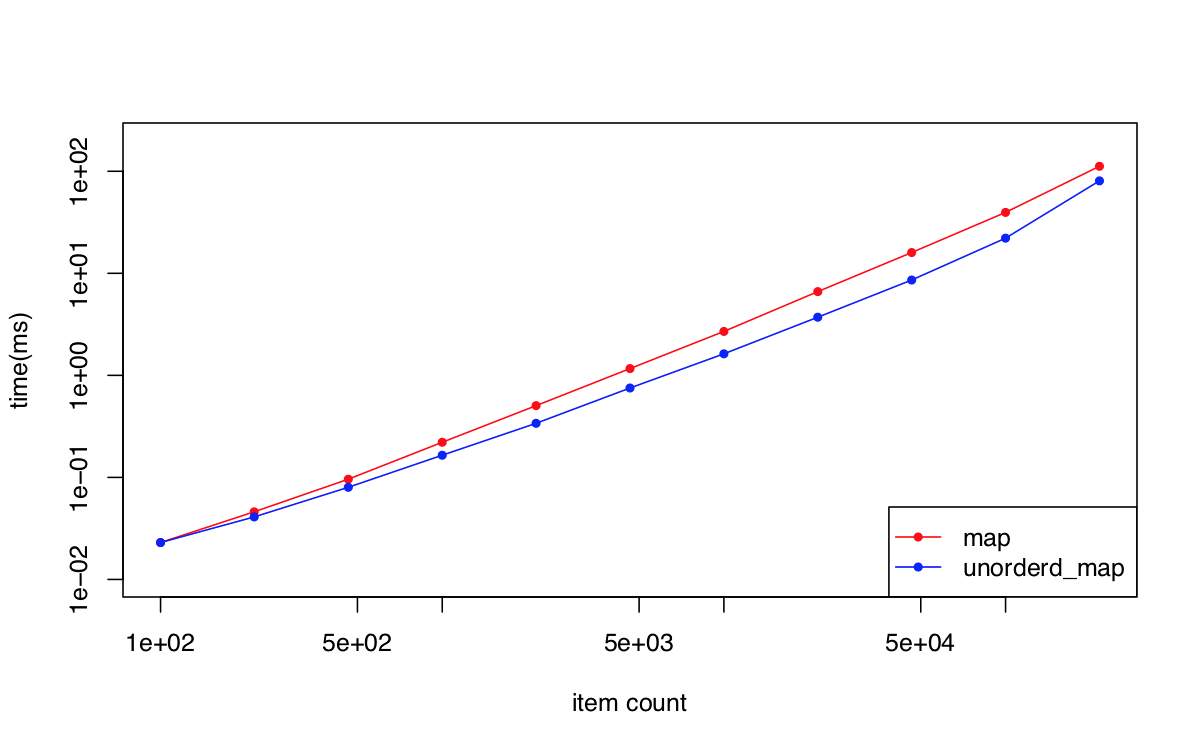std::map と std::unordered_map のどちらが速いのかを比較する。
コメント欄で、boost::flat_map も参戦。
この記事の続編は
結論
unordered_map の方が速いこともあるし、 map の方が速いこともある。
やったこととやってないこと
やったこと
- C++11 で、
std::map<std::string, int>とstd::unordered_map<std::string, int>のemplaceをたくさん呼んで、その部分の時間を測定するコードを書いた。 - キーはランダムな文字列。長さはコマンドライン引数で指定
-
emplaceする要素の数は、コマンドライン引数で指定 - 上記コードからできたバイナリをたくさん呼んで csv化するスクリプトを ruby で書いた。
- 上記コードで出来上がった csv をグラフにするスクリプトを R で書いた。
- 全部実行した。
やってないこと
-
emplace以外の操作の時間を測ること -
<std::string, int>以外のテンプレートパラメータについての調査 - ランダムな文字列以外のキーについての調査
- ランダムな順序以外での挿入
実験に使ったソースコード
まずは C++11 のコード。
// clang++ -std=c++11 -O2 bench.cpp -o bench
# include <iostream>
# include <chrono>
# include <map>
# include <unordered_map>
# include <string>
# include <vector>
# include <cstdlib>
# include <random>
char randchar()
{
static std::mt19937_64 rng(0xbeef);
std::uniform_int_distribution<> dist(1, 255);
return static_cast<char>(dist(rng));
}
std::vector<std::string>
prepare(int len, int count)
{
std::vector<std::string> r;
r.reserve(count);
for (int vi = 0; vi < count; ++vi)
{
std::string s;
s.reserve(len);
for (int si = 0; si < len; ++si)
{
s += randchar();
}
r.push_back(std::move(s));
}
return r;
}
template <typename map_t>
void run(int len, int count)
{
using mapped_type = typename map_t::mapped_type;
std::vector<std::string> srces = prepare(len, count);
auto start = std::chrono::high_resolution_clock::now();
map_t map;
for (auto &&s : srces)
{
map.emplace(std::move(s), mapped_type());
}
auto end = std::chrono::high_resolution_clock::now();
std::cout
<< std::chrono::duration_cast<std::chrono::microseconds>(end - start).count() * 1e-3
<< "ms"
<< std::endl;
}
int main(int argc, char const *argv[])
{
char type = *argv[1];
int len = std::atoi(argv[2]);
int count = std::atoi(argv[3]);
switch (type)
{
case 'm':
run<std::map<std::string, int>>(len, count);
break;
case 'u':
run<std::unordered_map<std::string, int>>(len, count);
break;
default:
std::cout << "unexpected type" << std::endl;
}
}
上記のソースをコンパイルした結果を、ruby で走らせる:
require "csv"
def run( t, len, count )
r = %x( ./bench #{t} #{len} #{count} ).gsub( /ms\s*/, "" )
[t, len, count, r]
end
N=16
def out(csv,data)
csv << %w( len count u m )
data[0].zip(data[1]).each do |a,b|
csv << [ a[1], a[2], a[3], b[3] ]
end
end
CSV.open( "len.csv", "w" ) do |csv|
data = %w( u m ).map do |t|
N.downto(6).map do |e|
p e
run(t, (10**(e/3.0)).round, 1000) # 平準化のために走らせる
run(t, (10**(e/3.0)).round, 1000)
end
end
out(csv,data)
end
CSV.open( "count.csv", "w" ) do |csv|
data = %w( u m ).map do |t|
N.downto(6).map do |e|
p e
run(t, 10, (10**(e/3.0)).round) # 平準化のために走らせる
run(t, 10, (10**(e/3.0)).round)
end
end
out(csv,data)
end
そして出来上がった CSV を R でグラフにする
pdf("len.pdf", width=8, height=5) # 8×5 inch
dt<-read.csv("len.csv")
plot(
dt$len,dt$m,
col="red",
type="o",
pch=20,
log="xy",
xlab="string length",ylab="time(ms)",
ylim=c(0.1,30))
lines(dt$len,dt$u,col="blue",type="o",pch=20,xlab="foo",ylab="hoge")
legend("bottomright", legend=c("map", "unorderd_map"),pch=20,col=c("red","blue"),lwd=1,lty=1)
dev.off()
pdf("count.pdf", width=8, height=5) # 8×5 inch
dt<-read.csv("count.csv")
plot(
dt$count,dt$m,
col="red",
type="o",
pch=20,
xlab="item count",ylab="time(ms)",
log="xy",
ylim=c(0.01,200))
lines(dt$count,dt$u,col="blue",type="o",pch=20,xlab="foo",ylab="hoge")
legend("bottomright", legend=c("map", "unorderd_map"),pch=20,col=c("red","blue"),lwd=1,lty=1)
dev.off()
測定結果
結果その1 - 文字列長を変えて、要素数固定
キーになる文字列の長さを変えて測定。要素数は 1000 で固定。

両対数グラフ注意。
今回の実験ではランダムな文字列を使っている。
map の場合は比較ができればよい。比較の場合最初の数文字を見ればいいだけなので、文字数が多くなっても比較に要する時間は変わらない。
したがって、mapの方は文字列長の影響を受けない。
※ グラフがデコボコしていて気持ち悪けど、気にしないことにした。
一方unorderd_mapの場合、Hash値を計算するために文字列を最後まで舐める必要がある(と思われる)。そのため、文字列が長くなると遅くなる。
予想通りの結果だった。
結果その2 - 要素数を変えて、文字列長固定
両対数グラフ注意。
unordered_map の方が速いものの、その差は1〜1.8倍程度。要素数が多くなっても差が開くことはなかった。
差が開くと予想していたので、予想は外れた。
まとめ
- 文字列が長い要素がたくさんある(そして、最初の数文字を見れば比較が終わる事が多い)場合は、
mapの方が速くなりがち。 - それ以外の場合は、
unordered_mapの方が速くなりがち。 - 今回の実験は、ランダムなキーをランダムな順序で挿入している。それ以外のパターンについては今回の実験からはわからない。
